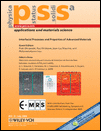Modification/oxidation of GaAs surface in electrolytes for cell-culture bio-sensing devices
Abstract
The surface modification/oxidation of GaAs substrates in electrolytes has been investigated from the viewpoint of bio-sensing devices using AlGaAs/GaAs high-electron-mobility-transistor (HEMT) structures, where the cell culture directly on a bare gate-surface is intended for a high sensitivity to cell-viabilities such as adhesion or cell-cell interaction, through nitric-oxide concentration or charged-peptide chemisorption. Although GaAs surface (gate surface of HEMT) was oxidized even in pure water under room light, we found that the oxide layer is not formed in the dark or removed with the existence of small amounts of NaH2PO4 (0.8 mM) in the solution. The photo-excited oxidation and its etching by NaH2PO4 are discussed as well as the temporal change of the HEMT performance in solution. Cell adhesion on a bare GaAs surface was poor, but a surface modification by fibrionectin improved the cell adhesion, comparable to that on the conventional cell-culture dishes. (© 2006 WILEY-VCH Verlag GmbH & Co. KGaA, Weinheim)




